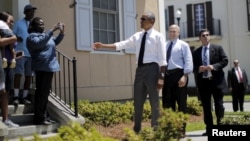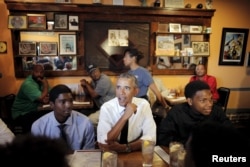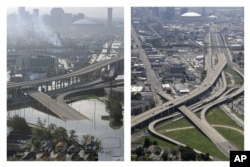Ten years after Hurricane Katrina hit New Orleans, killing 1,800 people and destroying 100,000 homes, President Barack Obama hailed the southern U.S. city’s revival.
“You are an example of what is possible when, in the face of tragedy and in the face of hardship, good people come together to lend a hand," Obama said on a visit Thursday to the Louisana city. "And brick by brick, block by block, neighborhood by neighborhood, you build a better future."
In a speech at a newly built community center in the city’s Lower Ninth Ward that was badly hit by the hurricane, the president highlighted New Orleans’ recovery and "remarkable progress" after suffering massive flooding.
"The project of rebuilding here wasn't simply to restore the city as it had been. It was to build a city as it should be," he told a crowd of 600. "A city where everyone, no matter who they are or what they look like or how much money they've got, has an opportunity to make it."
The president began his remarks marking the 10th anniversary of Hurricane Katrina by noting the fast, steady and strong recovery of the U.S. economy.
Obama said despite weeks of volatility in the global stock markets, "the United States of America, for all the challenges we still have, we continue to have the best cards – we just have to play them right."
Storm Impact
The storm that slammed into New Orleans on August 29, 2005, broke through protective levies and left more than 80 percent of the city under water.
Torrential rains and winds up to 280 kilometers an hour raked the city near the Gulf of Mexico.
"The world watched in horror as we saw those rising waters drown the iconic streets of New Orleans, families stranded on rooftops, bodies on the streets, children crying, crowded in the Super Dome," Obama said.
Katrina caused more than $135 billion in damage, making it the costliest natural disaster ever in the United States.
"What started out as a natural disaster became a man-made disaster, a failure of government to look out for its own citizens," the president noted.
Much of the U.S. Gulf Coast was heavily damaged by the storm, resulting in billions of dollars in federal assistance spent to help coastal communities rebuild.
Obama, on his 10th visit to the coastal city, remarked that New Orleans’ recovery is a model for the nation in urban innovation and disaster response and resilience. More than $14 billion has been spent to reinforce levees that failed to protect New Orleans.
The president also noted the importance of making communities more resilient to natural disasters.
"We are going to see more extreme weather events as the result of climate change, deeper droughts, deadlier wildfires, stronger storms," he said. “That’s why, in in addition to things like new and better levies, we have also been investing in restoring wetlands and other natural systems that are just as critical for storm protection."
Rebuilding communities
Prior to his speech Thursday, Obama and New Orleans Mayor Mitch Landrieu walked through the historic African-American neighborhood of Treme, home to jazz legends.
Treme was flooded during Hurricane Katrina, with many areas completely submerged under several meters of water. Many fled their neighborhood after the storm and never came back. Others have moved into new mixed-income housing constructed on the site of former public housing projects.
During his stroll Thursday, Obama met with several residents who waited outside their newly constructed homes. He later spoke to reporters about the community’s revitalization.
"Part of our goal has always been to make sure not just that we recover from this storm, but also that we start dealing with some of the structural inequities that existed long before the storm happened," he said.
Obama pointed out that just because the residents have nice housing does not mean the job is done. He noted the need to combat poverty, income inequality and a lack of affordable housing, particularly among the African-American community.













